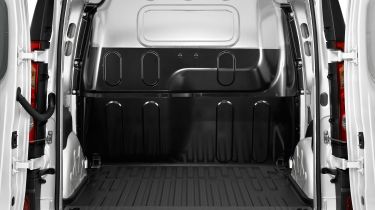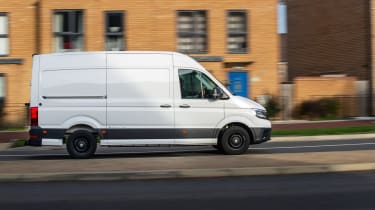Electric van payloads and driving-licence requirements
Electric van payloads are similar to those of normal vans, but not identical. We explain everything here

Maximum payload regulations apply to electric vans in exactly the same way as they do to internal-combustion-engined vans: there's a maximum payload, and it mustn't be exceeded at any time, for safety reasons. One thing to be aware of, however, is that because an unloaded electric van usually weighs a bit more than an unloaded diesel van (due to the presence of battery packs), an electric van's maximum payload can in turn be a little less than an equivalent diesel model's.
To take one example, the Nissan NV200 has a maximum payload of 728kg, whereas its electric equivalent, the e-NV200, tops out at 705kg. It's a similar story with the Renault Master: the diesel can take 1,536kg, which is 436kg more than the Renault Master E-TECH electric model. The Volkswagen e-Transporter, meanwhile, has a maximum payload of 1,096kg, compared to a top figure of 1,309kg for the diesel version.
Plug-in hybrid vans are thin on the ground for now; the only one currently available is the Ford Transit Custom PHEV. The difference between electrified and non-electrified isn't as stark here, because the combination of the smaller battery pack and petrol engine is roughly similar in weight to a diesel setup. As a result, the Transit Custom PHEV can carry up to 1,130kg, which isn't far off the diesel Transit Custom.
As a rule of thumb, an electric or hybrid van probably won’t be able to carry as quite as much weight as its direct petrol or diesel equivalent, although most electric models currently for sale are designed for jobs that focus more on payload volume than weight. And in this area, manufacturers generally strive to ensure the load volume is exactly the same, by placing electric versions' batteries in the floor of the van.

What licence do I need to drive an electric van?
Of course, payloads come into play when it comes to determining what vans certain driving-licence holders are allowed to drive. The UK government has acknowledged the difference in maximum payload between equivalent electric and diesel van models and tweaked the regulations to account for his.
A temporary derogation was announced in 2018, applying to the 3,500kg maximum allowable mass (MAM) of vehicles driven by holders of the standard B and B1 driving licences issued from 1 January 1997 onwards.
It covers alternatively-fuelled vehicles only, and raises the MAM (also referred to as the maximum gross vehicle weight, or MGVW) of electric, plug-in hybrid, range-extender or hydrogen fuel-cell vans that those licence holders are allowed to drive to 4,250kg. Note that if you passed your driving test before 1 January 1997, you already have the C1 entitlement that allows you to drive anything up to a maximum gross vehicle weight of between 3,500kg and 7,500kg.
It’s worth noting that while the MAM has been raised for electric vans, this also means that they're subject to additional restrictions; those above 3,500kg fall into the heavy goods vehicle (HGV) category. That means a tachograph must be fitted to log driver hours at the wheel, while a 60mph speed limiter is compulsory, too.
In theory, the move allows heavier electrified commercial vehicles to compete on an even playing field with petrol and diesel vehicles, with authorities hoping to encourage drivers and businesses towards less polluting modes of transport. It’s worth double-checking how much weight you’re allowed to drive on the road before you get behind the wheel: anyone caught exceeding the legal limits can be fined and face prosecution.
In addition, if you’re using an electric van to tow, you can pull a trailer weighing up to 750kg, as long as the overall MAM remains under the maximum figure of 4,250kg. Remember that a standard driving licence only provides you with a provisional licence to tow; you need to take the B+E driving test to do it legally.
Most Popular

EV Deal of the Day: Dacia Spring is amazingly good value at £116 per month


